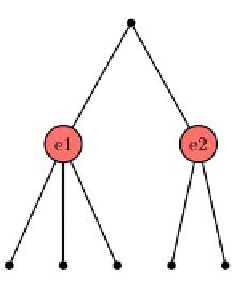Information Technology Reference
In-Depth Information
, betting strategies depends on the gamestate [16] (that can be Pre-
Flop, Flop, River). During these gamestates, players' hands are consistent with
their actions. Thus simulations are limited to special tracks that are defined by
players' hands.
These contributions in other stochastic games show that biased sampling ac-
cording to particular things of gamestates and regrouping possibilities has been
used to settle ecient
In
Poker
MCTS
playouts.
3 Regrouping Nodes
In this section, we present the use of chance-nodes, move-groups and group-nodes
principles applied to
MCTS
.
Fig. 1.
Common, chance-nodes and move-groups representations
Figure 1 show the differences between representations of a common tree, a
tree with chance-nodes and a tree with move-groups. With chance-nodes and
move-groups, branching factor reductions can arise. With chance-nodes (related
to a game where possible moves are partly defined by rolling a dice), events
e1
and
e2
are selecting possible next nodes. With move-groups, children are
divided between categories (here 3 categories
A
,
B
and
C
) to perform a smart
descent towards the best leaf. When these categories are defined by the moves
coordinates in the board, move-groups are called group-nodes.
The main loop of
applied to perfect information games is presented
in Alg. 1. It is a statistical search based on 3 steps called
selection
,
expansion
and
backpropagation
, also guided by random games (
i.e.
playouts). The tree
expansion is performed to evaluate the current most promising node. The main
loop presented is limited to
nbPlayouts
iterations but it can be an anytime
process. It can start from an empty tree with its root node only or from a tree
filled by previous
MCTS
loops. The use of such procedure is consistent if and
only if the root node is not a
endgame
position (
i.e.
root is not a solved problem).
This process can lead to the insertion of 1 to
nbPlayouts
nodes. The
select
MCTS





Search WWH ::

Custom Search